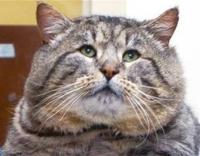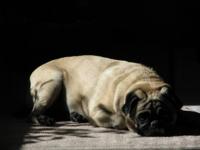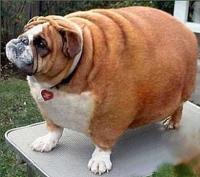Chubby Pets
The statistics aren’t good. Our pets are packing on the pounds more than ever! You know chubby pets are becoming a problem when there is an organization called the Association for Pet Obesity Prevention! They conduct a survey annually to find out how our overweight cats and dogs are doing. Their data was combined with data from the American Veterinary Medical Association to give us these sobering statistics from 2012:
- 80 million U.S. dogs and cats are overweight or obese
- 58.3 percent of cats are overweight or obese
- 52.5 percent of dogs are overweight or obese
To add to the problem, another study showed that 40% of pet parents didn’t think their pets were overweight, when in fact they were. This compounds the problem because the first step is recognizing your chubby pet needs help.
Let’s put this into perspective. Imagine your 10 pound Fifi or Mittens is actually tipping the scales at 20 pounds.
If you are supposed to weigh 150 pounds, you now have 300 pounds packed on! This is an extreme example, but not rare. It’s not unusual for overweight cats and dogs to be twice their normal weight.
Factors Contributing to Overweight Cats and Dogs
Certain breeds are more likely to gain weight. These breeds seem to gain even with small amounts of food. However, treats are often one of the culprits that pet parents don’t think about. We often equate food with love, so it’s easy to overdo treats! Those calories can add up quickly, especially in smaller pets. Also, consider edible chew bones when you start counting calories.
Spaying and neutering our pets is a great idea, however it slows down their metabolism, adding to the problem of too many overweight cats and dogs.
As pets get older, they tend to gain weight as well. Too many of our chubby pets are couch potatoes. Their idea of exercise is to stretch and reposition themselves!
Some cats and dogs become overweight because the pet parent is following the instructions on the bag of pet food. I have found that often, the recommendations are too high. It is just a guideline. Also, studies have also shown that homemade and raw diets are often too high in calories. For these cats and dogs, weight loss must be addressed.
Health Risks Associated with Pet Obesity
We all know that extra weight is not good for us. The same is true for our chubby pets. Several conditions are associated with obesity including:
- Diabetes
- Arthritis and ruptured ligaments
- Slipped disks in the back
- Cancer
- Heart problems
- Skin problems
- Urinary tract problems
- Dental disease
- Cushing’s disease
- Liver disease (especially cats)
These conditions are serious. This list alone should give you good reasons for helping your overweight cats and dogs lose weight!
Your pet is also at greater risk from anesthesia and surgery. It is more difficult to draw blood samples and to propely examine an overweight pet. However, the worst risk is overweight cats and dogs live 2-2 ½ years less.
Body Condition Assessment
The first thing to do is decide if you have a chubby pet. Look and feel for these:
- You should be able to see a waist when you look down on your pet. There should be an indentation in front of the hips. If you see “love handles” by the hips, you can be assured there is no waist!
- Your pet should have a tucked up belly when you look at the side. If it looks like your pet is a straight line or even sags, that’s usually excess fat. Cats may not have a pronounced tuck. They have a fat pad in the abdominal area between the hind legs. This should be minimal if your cat is a normal weight.
- You should be able to feel the ribs well enough to count them. There shouldn’t be more than slight fat over them. In overweight cats and dogs, the ribs can be difficult to feel.
Cat and Dog Weight Loss Plans
If your chubby pet does need to lose weight, decide how much or start with a few pounds and after a month or so take another close look. Then adjust your plan if he needs to lose more weight. Go slowly.
Before starting a cat and dog weight loss plan, it’s helpful to write down everything your pet eats during a 3-day period. This allows you to see how many treats or other things your pet eats in addition to his food. Measure his food so you know exactly how much he’s been getting.
Cut back on calories
You can decrease the amount of his normal diet to start with. One drawback of this method is that your pet may still be hungry since he was used to the other amount. If you cut back too much, your pet may not be getting all the nutrition he needs. To assist with cat and dog weight loss, foods high in fiber can be fed to help your chubby pet feel full on fewer calories.
Companies are assuming your pet is eating a normal amount when they decide how much vitamins, etc. to put into their food. If your pet is eating a lot less, he won’t be getting everything he needs.
Using a diet made for cat and dog weight loss is a good choice to avoid this problem. I would start with a prescription diet from your vet.
Eliminate high calorie treats! You may not need to cut back on his food as much. Switch to low calorie treats given in small amounts or, better yet, give vegetables (not corn or peas). Cut back on the number of edible chews and give your dog chew toys.
Increase exercise
Get your pet moving! This can be difficult because your chubby pet needs to spend time exercising. That, in turn, usually means you have to be walking or playing with him.
Tips for cats
- Use a laser pointer or wand type toy for play
- Put food in high places to make your cat jump
- Provide climbing areas
- Hide food in a ball or toy that he has to move
If your pet is obese or has arthritis, start slowly. You may need to have him lose some weight first before staring an exercise program.
Summary
Summary
Excess weight can have a serious effect on your pet’s health.
An exam by your vet is a good idea if your chubby pet has many pounds to lose. You also want your pet examined if you’ve tried getting him to lose weight and it’s not working. Your vet can make sure there aren’t any medical problems contributing to his weight and help you develop a plan.
Decreasing calories and increasing exercise is what is needed. It’s often hard for everyone, but it’s worth it. Keep reminding yourself, your pet will live longer!
Category:
All articles are reviewed and maintained by whiskerDocs team of veterinary experts.




